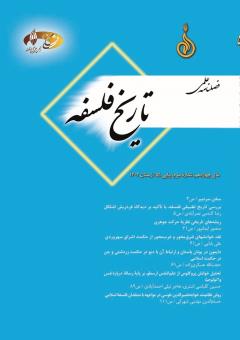دایمون در یونان باستان و ارتباط آن با دیو در حکمت زردشتی و جن در حکمت اسلامی
محورهای موضوعی : ریشهشناسی مکاتب و آراء فلسفی در ادوار قدیم و جدید
1 - دانشآموختۀ دکتری فلسفۀ، دانشگاه آزاد اسلامی، واحد علوم و تحقیقات تهران، تهران، ایران
کلید واژه: دایمون, دیمن, دیو, جن, تئوس, دایوا, ملک, حکمت زردشتی, یونان باستان, عهد جدید,
چکیده مقاله :
حقایق مشترکی در مورد دایمون در یونان باستان و دیو در حکمت زردشت و جن در الهیات اسلامی وجود دارد. اگرچه در حکمت یونانی گاه میان دایمون و تئوس تمایز نهاده شده، اما در اغلب موارد، دایمون با موجودات الهی و فراطبیعی خلط شده و این چالش را پدید میآورد که چگونه خدایان یونان باستان، در دورۀ مسیحیت و پس از آن، بتدریج به دیو و شیطان تبدیل میشوند. در حکمت زردشتی نیز میان ایزدان الهی و دیوان، نهتنها تمایز، بلکه تضاد و تقابل تام برقرار است؛ اولی، الهی و خیر، و دیگری، شر و شیطانی است. در جهانبینی و آموزههای اسلامی هم موجودی بنام «جن» وجود دارد که نه از سنخ ملک و فرشته است، و نه مطلقاً شر و شیطانی؛ از یک طرف به عالم تجرد و ملائکه نزدیک است و میتواند کارهای فراطبیعی و فرابشری انجام دهد، و از طرف دیگر، در مواردی بسیار، منشأ امور شر و پلید است، که در این حالت شیطان نامیده میشود. میتوان بر اساس رویکرد فیلسوفان مسلمان در طبقهبندی موجودات روحانی و غیرجسمانی، و تمایزی که میان ملائکه، جنهای صالح و شیاطین نهادهاند، چالشهای مربوط به دایمونهای یونان باستان را بنحوی دقیقتر تبیین نمود. این تبیین نقشی مهم در فهم ریشۀ آراء و مکاتب حکمت قدیم، بویژه حکمت یونان باستان خواهد داشت تا با آگاهی از ماهیت جن و جنیان، بتوان نقش دایمونها در یونان باستان را بوضوح تعیین کرد.
There are some shared truths regarding daemon in ancient Greek, div in Zoroastrian wisdom, and jinn in Islamic theology. Although daemon is in some cases distinguished from theos in Greek philosophy, it is usually confused with other divine existents, thus creating the challenge of how ancient Greek gods gradually turned into div and Satan during the Christian period and after that. In the same vein, there is not only a distinction but also total contrast and opposition between Divine gods and divs in Zoroastrian wisdom. The former is divine and good while the latter is evil and satanic. There is also an existent called “jinn” in Islamic worldview and teachings that is neither angel-like nor of an absolute evil nature. On the one hand, it is close to the world of immateriality and angels and can perform supernatural and superhuman acts; on the other hand, it is the origin of evil and wicked affairs in several cases, thus deserving the name of Satan. However, it is possible to explain the challenges related to ancient Greek daemons more accurately based on Muslim philosophers’ approach in classifying spiritual and immaterial existents and the distinctions that they make among angels, good jinns, and evils. This endeavor plays an important role in understanding the roots of the ideas held in ancient schools of philosophy, particularly in ancient Greece, so that one can clarify the role of daemons in ancient Greece more effectively.
قرآن کریم.
اوستا، کهنترین متنها و سرودههای ایرانی (1371) گزارش و پژوهش جلیل دوستخواه، ج1 و 2، تهران: مروارید.
افلاطون (1380) دورۀ آثار افلاطون، ترجمۀ محمدحسن لطفی، تهران: خوارزمی.
دهخدا، علیاکبر (1352) لغتنامه، تهران: دانشگاه تهران.
راغب اصفهانی، حسین بن محمد (1412 ق) مفردات ألفاظ القرآن، بیروت: دار القلم.
شفیعبیک، ایمان (1395) «الهام و معرفت در فلسفۀ سقراط و افلاطون»، فصلنامۀ فلسفه، سال 44، شمارۀ 2، ص102ـ85.
صلیبا، جمیل (1414ق) المعجم الفلسفی بالألفاظ العربیة و الفرنسیة و الإنکلیزیة و اللاتینیة، بیروت: الشرکة العالمیة للکتاب.
قرشی بنایی، علیاکبر (1412ق) قاموس قرآن، تهران: دار الکتب الاسلامیه.
لاهیجی، عبدالرزاق (1383) گوهر مراد، تهران: سایه.
ملاصدرا (1363) مفاتیح الغیب، تهران: مؤسسۀ مطالعات و تحقیقات فرهنگی.
ملاصدرا (1368) الحکمة المتعالیة فی الأسفار العقلیة الأربعة، قم: مصطفوی.
ناس، جان بایر (1386) تاریخ جامع ادیان، ترجمۀ علی اصغر حکمت، تهران: علمی و فرهنگی.
Interlinear Bible.
The Apostolic Bible Polyglot (2006). trans. by C. Vanderpool. Apostolic Press.
Bryant, E. & Laurie, P. (2005). The Indo-Aryan Controversy: Evidence and Inference in Indian History. New York: Routledge.
Burkert, W. (1996). Greek Religion. trans. by J. Rallan. Basil Blackwell Ltd.
Charlton T. L. & Short, Ch. (1879). A Latin Dictionary. Oxford: Clarendon Press.
Eusebius (1903). Preparation of the Gospels. trans. by the Rev. Edwin. Hamilton Gifford; Https://topostext.org.
Flint, V.; Gordon, R. & Luck, G. (1999). Witchcraft and Magic in Europe: ancient Greece and Rome, London: The Athlone Press.
Guru, Sh. B. (2015). A brief history of the Immortals of Non-Hindu civilizations, Notion Press.
Herrenschmidt, C. & Kellens, J. (1993). “Daiva”. Encyclopaedia Iranica, vol. 6. Costa Mesa: Mazda, pp. 599-602.
Hesiod (1914), Works and Days. theogony, Shield of Heracles, Miscellany, and Fragments, translated by H. G. Evelyn-White; https://topostext.org.
https://biblehub.com/interlinear/apostolic
https://en.wikipedia.org/wiki/Daeva
https://en.wiktionary.org/wiki/genius
https://www.encyclopedia.com/religion/encyclopedias-almanacs-transcripts-and-maps/daimon
Liddell, H. G. (1882). Greek English Lexicon. American Book Company.
McDonough, S. M. (2009). Christ as Creator Origins of a New Testament Doctrine. Oxford University Press.
Plato (1903). Platonis Opera. ed. by J. Burnet. Oxford University Press.
Plutarch (1874). Plutarch's Morals. translated from the Greek by several hands, corrected and revised by. W. W. Goodwin. Cambridge: Press Of John Wilson and son.
Plutarch (1936). Moralia. with an English translation by F. C. Babbitt. Cambridge: Harvard University Press.

